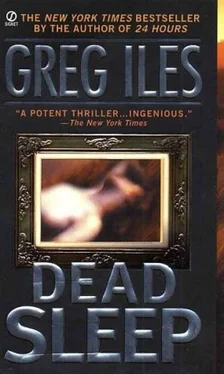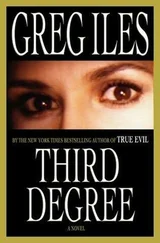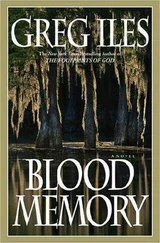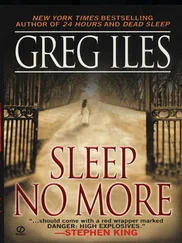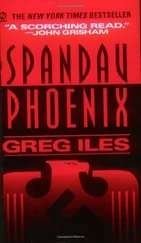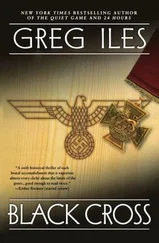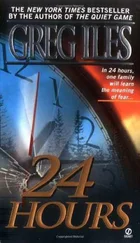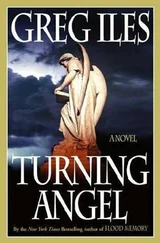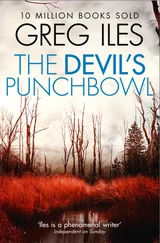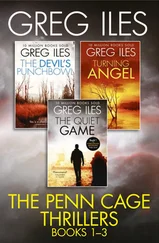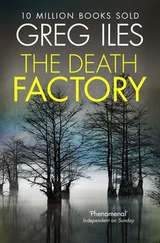“Mrs. Pitre, did Mr. Johnson show you any identification when he moved in?”
“Hell, yes. I asked for it, didn’t I? Since Ray got killed in the mud tank, I can’t be too careful. World’s full of crazy people. Black or white don’t matter these days.”
John seems nonplussed by Mrs. Pitre’s hyperactive style. “What did he show you?”
“Voter registration card, for one thing.”
“A Louisiana card?”
“Nope. New York City. He had a New York driving license, too.”
“He showed you that?”
“How else would I know he had it?”
“Of course. Did it have his picture on it?”
“What good is it without one? He wasn’t a bad-lookin‘ man, either. A little hard in the face, but you live long enough, life makes you hard. Isn’t that right?”
“We would like to go up now, Mrs. Pitre. Is it just one room over the garage?”
“Two rooms and a bathroom. Ray built it for Joey after we give him that set of drums. Couldn’t stand having him in the house with that racket. I don’t know if he was any good, but he could wake the dead with them.”
“I see. Do you mind if we go up alone? We like to see things completely undisturbed.”
Mrs. Pitre isn’t overjoyed by this, but after a moment, she hands over the keys. “I want a receipt for anything you take.”
“You’ll get that.” John turns to me and pulls me aside. “I’m going up with Daniel and Lenz for a quick look. I’d like to take you up, but it wouldn’t fly with the forensic unit.”
“I’m okay. Go on.”
John confers with the head of the forensic unit, who hands him a sheaf of plastic evidence bags. Then he, Lenz, and Baxter climb the stairs inside the garage. Mrs. Pitre sidles my way as I watch, figuring a woman might give her more information, so I flee to the FBI sedan and lock myself in the front seat.
The roar of an outbound jet rattles the car and my bones, and I wonder why Mrs. Pitre isn’t as crazy as a road lizard rather than slightly addled. As I settle in for a wait, John limps down the bottom four steps.
“Is it your leg?” I call, getting out and hurrying toward him.
“No.” There’s an evidence bag in his hand. He waves to the chief of the forensic unit, and a platoon of technicians hurry toward the garage with their cases and bags.
“What is it? What did you find?”
“The UNSUB knew we were coming. The place was wiped clean, like the cell phone. All we found was a stash of junk food: Pop-Tarts, potato chips, Hostess Twinkies, and beef jerky. He must have worn gloves when he bought them. But waiting for us on the kitchen counter was a perfect row of photographs.”
A strange chill runs along my shoulders. “The victims?”
“Yes.”
“How many?”
“Eleven. Not the woman from Dorignac’s grocery, and not Thalia.”
“So he didn’t take the Dorignac’s victim.” I realize John is still holding the evidence bag. “What’s in that?” I ask, my chest tightening.
John sighs and touches my arm. “Jane’s photo. If you’re up to it, I’d like you to see if you can tell me where it was taken.”
“Let’s see it.”
He hesitates, then opens the Ziploc and slides out the photo. It’s a black-and-white print, shot with a telephoto lens. The depth of field is so poor that I can’t distinguish the background, but Jane is clear. Wearing a sleeveless sweater and jeans, she’s looking toward the camera but not into it. She looks more intense than usual, her eyes narrowed in the way people tell me mine do when I’m concentrating. As I study the image, searching for some telling detail, anything that might yield a clue to her fate, my heart clenches like a fist and my skin goes cold.
“Are you okay?” he asks, taking hold of my shoulders. “I shouldn’t have showed that to you.”
When he touches me, I realize he’s shaking. His wounded leg is barely supporting his weight.
“Look at her arms, John.”
“What about them?”
“No scars.”
“What?”
A wave of vertigo throws me into a spin, though I know I’m standing still. “Jane was attacked by a dog when she was little.”
“Dog?”
The photo begins to quiver in my hand as realizations clamor for attention. I’ve seen this photograph before. But the copy in my hand isn’t a true photo print; it’s an ink-jet facsimile printed on photo paper. Fighting tears, I press the picture to my chest and close my eyes.
“Careful,” John warns. “There might be fingerprints.”
“Look!” Dr. Lenz says over John’s shoulder. “There’s something written on the back.”
John leans forward and studies the back of the print. “It’s an address. Twenty-five-ninety St. Charles.”
“That’s Jane Lacour’s address,” says Lenz.
“There’s a phone number, too.”
“Seven-five-eight, one-nine-ninety-two?” I ask.
“No,” John says softly. “It’s a New York number. We need to trace this right away.”
He reaches for the picture, but I push his hand away, turn over the photo, and read the number: 212-555-2999.
“I know this number,” I whisper.
“Whose is it?” John asks.
“Just a second.” I try to think back through a haze of scotch and Xanax. “Oh my God… it’s Wingate’s gallery. Christopher Wingate. I dialed this number from the plane back from Hong Kong.”
“Jesus,” John says under his breath. “That’s everybody tied in the same knot. Wingate, the UNSUB, and de Becque. They’re all tied together now.”
“Wingate’s number on a victim’s photo,” muses Lenz. “That could mean Wingate selected Jane Lacour.”
“How could he?” asks John. “He hasn’t been in New Orleans for years.”
“He didn’t choose Jane,” I whisper. “He chose me.”
The causeway across Lake Pontchartrain is the longest bridge in the world built solely over water. The twenty-three miles of humming concrete and traffic push me inward like a mantra, toward the dark vortex of my fear and guilt. Somewhere on the other side of this shallow lake, amid the exploding construction caused by white flight from New Orleans, stands the house of John Kaiser. The man himself sits beside me in the passenger seat of my rented Mustang, the seat fully reclined so that he can stretch out his wounded leg.
Thirty seconds after he read Christopher Wingate’s number off the back of my photograph, John’s leg gave way and he collapsed in Mrs. Pitre’s driveway. Baxter ordered him back to the hospital, but John argued that he was only tired, that he should have used the walking cane, and that he had to return to the field office to work the new connections between the UNSUB, Wingate, and Marcel de Becque. Baxter gave him two choices: go back to the hospital or go home and rest for the night. John chose the latter, but as we picked up my Mustang from the field office, he called upstairs and had an agent bring down a thick folder filled with the latest Argus-generated enhancements of the abstract Sleeping Women. He’s like I used to be when I got my teeth into a war story – unstoppable.
The picture he pulled from the Ziploc bag floats in my mind like a grayscale emblem of guilt. I’ve placed the photo now. It ran in several major newspapers two years ago, when I won the North American Press Association Award. Wingate must have accessed some database that contained that picture, printed it on photo-quality paper, and sent it to the UNSUB in New Orleans.
“Do you want to talk about it?” John reaches out and touches my knee.
“I don’t know.”
“I know what you’re thinking, Jordan. A little survivor guilt is normal, but this is crazy. You’re forcing everything to fit a predetermined result. And the result you’re reaching for is that Jane died because of you. I don’t know why you want to feel that guilt, but that’s not what happened.”
Читать дальше
Конец ознакомительного отрывка
Купить книгу
